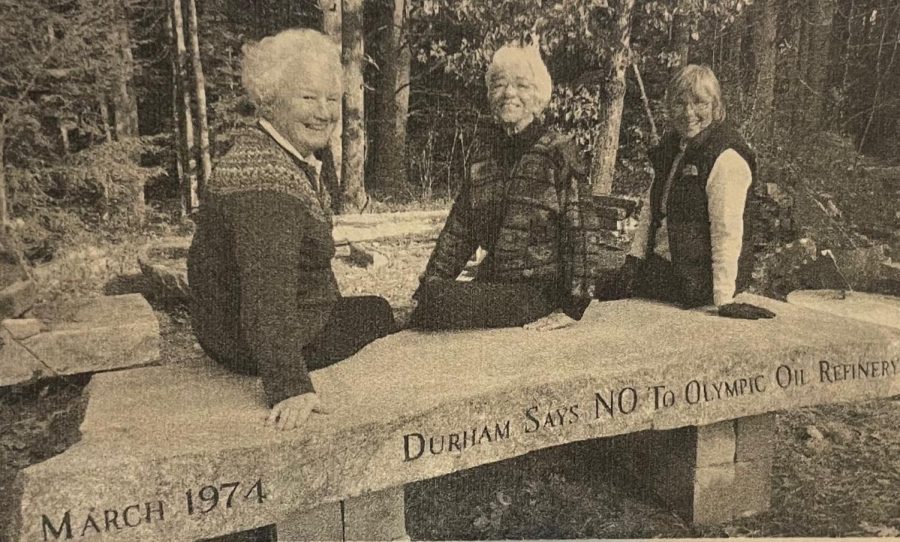Dudley and Sandberg reflect as Mill Pond Dam debate comes to a head
Nearly 50 years later, it feels “about the same”
March 7, 2022
DURHAM – It was fall 1973 when freshman state legislator Dudley Dudley’s nap was interrupted by the “bringgg” of the telephone. Calling was Barbara Underwood, a Republican colleague whom she considered “one of the good ones.”
“Let me know if there’s anything I can do to help,” she told a confused Dudley, not knowing what problem needed the “help” Underwood was offering. She heard rumors about an oil refinery being built in Durham, the town Dudley represented and lived in, and was concerned about what it would mean for the Seacoast area.
Dudley spent the ensuing weeks talking to other legislators and local leaders to determine the credibility of Underwood’s claims. This brought her to Nancy Sandberg, a fellow Durham resident. She helped organize the citizen’s group Save Our Shores (SOS) after reports of “suspicious land dealings” near the Great Bay Estuary.
They eventually discovered the man behind the project was Greek shipping magnate Aristotle Onassis. His goal was to build an oil refinery, but he needed thousands of acres of land near the watershed to do so.
“At first, it seemed like a Durham Point Rd problem, but very soon people realized it was a big issue,” Sandberg said. “You’re talking about the world’s largest oil refinery, 400,000 barrels produced every single day.”
Onassis had the support of then-governor Meldrim Thompson Jr. and William Loeb, publisher of the only statewide newspaper, the Manchester Union Leader. The idea for the refinery was born out of the energy crisis felt throughout the entire country.
“The big, typical forces were against us: the governor, the statewide newspaper, the former president of the senate, the former speaker of the house. All sorts of powerful people,” Dudley said. “But we prevailed.”
Prevailed they did, with Onassis’ plans for a $600 million refinery scrapped after months of informational meetings from SOS. Those paved the way for Dudley’s legislation on home rule, where citizens of the town were able to vote if they wanted an oil refinery in their city or not.
“We were finding out what the impacts of refineries were from Texas and towns in California, and we knew it wasn’t right for Durham,” Sandberg said. “We learned all the reasons that you wouldn’t want an oil refinery in your town. The more people who learned about it, the more people who were opposed to it.”
Today, the pair find themselves in a similar battle against the Durham town council’s decision to remove the Mill Pond Dam.
“It feels about the same, in many ways,” said Sandberg. Dudley echoed, “It does. It does.”
Sandberg got involved in the issue through her role as director of the Durham Historic Association (DHA) and curator of their “tiny little museum.” She was instrumental in crafting multiple DHA letters to the council to support dam retainment.
“The dam is such an essential part of what this town has been and is and will be. I think there’s a much better way to go, which looks at the real problems – the pollutants flowing into the Oyster River and Great Bay,” Sandberg said. “We’ve got to get a handle on that.”
Dudley originally came at it from an angle of historic appreciation but realized there were more benefits to keeping the dam.
“It would hurt to see it go, but there are many reasons why it shouldn’t go. Only one of them is because of historical value, but there are many others. You can spell all the many others, and people say, ‘you’re clinging to nostalgia,’ but that’s only one reason,” she said.
The two also support retainment because of the 24-acre ecosystem the dam impounds. It has existed for over 372 years, and part of it is rated among New Hampshire Fish & Game’s highest-ranked habitats. That environment would be severely hampered if the dam is removed, and will be prevented from returning to its pre-colonial days by another dam, owned by UNH, 1.8 miles upstream.
“The most egregious error is leaving out the function of the UNH dam, almost two miles up river. To me, that feels like a set-up,” Sandberg said. “Whether it was intentional or not I can’t say, but it led people to believe that if you take the [Mill Pond] dam out that the Oyster River will run wild and free.”
Both have actively campaigned in recent months and think removing the dam is only addressing a symptom, not the problem: pollutants.
“We really need to look at why all these pollutants are flowing into our watershed. We need to address it much more aggressively,” Sandberg said.
The pollutants flow down from College Brook and Hamel Brook into the Mill Pond and remain there because of the dam. Dudley and Sandberg believe the lack of town maintenance led to today’s poor quality impoundment.
“The town has not been a good steward to the Mill Pond. And the run-off from highways and roads collects in the pond,” Dudley said. “If the dam is taken down, all those pollutants are going to be swept into the area on the other side of the bridge and out into the Estuary.”
Fighting for what they believe in is still crucial to each, even 48 years later. Though not up against the Onasis juggernaut, Dudley and Sandberg are hoping to preserve the sanctity of Durham once again.
“It’s symbolic. It’s beautiful, and I know beauty is in the eye of the beholder. Maybe some people like to see these little streams, but I want to see the pond,” Dudley said.
“It’s not just the image of it. It’s what it symbolizes. It’s what it represents,” said Sandberg. “A historic sign commemorating the dam just doesn’t do it.”
Photo courtesy of J. Dennis Robinson.





























